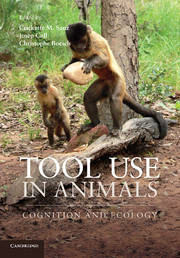Book contents
- Frontmatter
- Contents
- List of contributors
- Part I Cognition of tool use
- 1 Three ingredients for becoming a creative tool user
- 2 Ecology and cognition of tool use in chimpanzees
- 3 Chimpanzees plan their tool use
- Part II Comparative cognition
- Part III Ecology and culture
- Part IV Archaeological perspectives
- Index
- References
2 - Ecology and cognition of tool use in chimpanzees
from Part I - Cognition of tool use
Published online by Cambridge University Press: 05 March 2013
- Frontmatter
- Contents
- List of contributors
- Part I Cognition of tool use
- 1 Three ingredients for becoming a creative tool user
- 2 Ecology and cognition of tool use in chimpanzees
- 3 Chimpanzees plan their tool use
- Part II Comparative cognition
- Part III Ecology and culture
- Part IV Archaeological perspectives
- Index
- References
Summary
Introduction
Humans, as the most technological species, tend to assume that tool use is a sign of higher intelligence and that, over the course of our evolution, tools conferred a decisive advantage in the struggle to adapt to different environments (Mithen, 1996; Wynn, 2002; Wolpert, 2003; Dietrich et al., 2008). As such, animal species that use tools are considered more intelligent, while those that do not are judged as being less intelligent. This amounts to an anthropocentric judgment whereby humans adopt a human criterion to judge the adaptive skills of other species (Barrett et al., 2007; Goodrich & Allen, 2007). However, both phylogeny and ecology must be taken into account before one makes judgments about when and where we might expect tools to be used (Bluff et al., 2007; Hansell & Ruxton, 2008).
Tool use as an adaptation
Physical adaptations
If one remembers that, in most cases, tools are an extension of one’s body that allow an individual to solve tasks that cannot be solved with the body alone (Goodall, 1970; Beck, 1980; Boesch & Boesch, 1990), we must acknowledge that some primate species possess more efficient physical specializations than humans. For example, baboons have very hard, sharp teeth, which allow them to break open hard-shelled fruits that humans would be unable to open without the help of a tool (Kummer, 1968). Similarly, orangutans and gorillas, which are clearly physically stronger than humans, have been seen accessing food resources using sheer force in situations where humans would need to rely on tools (Schaik & Knott, 1996; Cipolletta et al., 2007). In addition to sheer force, it has been argued that hands help in tool use and this would then explain some of the distribution of tool use in the animal kingdom, although we should not forget that birds hold tools with their beaks and some otters use tools as well. Therefore, independent of the cognitive capacities required to use tools, tool use by animals should not be expected to occur in all situations where humans might use them. Our natural tendency to anthropomorphize hinders us from reaching a better understanding of the evolution of tool use, and it is imperative that we look directly to animals for answers about when tools might be beneficial.
- Type
- Chapter
- Information
- Tool Use in AnimalsCognition and Ecology, pp. 21 - 47Publisher: Cambridge University PressPrint publication year: 2013
References
- 17
- Cited by



